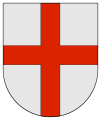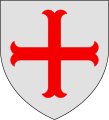Hochstift Paderborn (region)

The Hochstift Paderborn , often just Hochstift , sometimes also called Southeast Westphalia , is a region in the east of the German state of North Rhine-Westphalia with around 440,000 inhabitants . It includes the districts of Paderborn and Höxter , incorrectly also the old districts of Lippstadt and Brilon . It takes its name from the historic prince-bishopric, the Paderborn Monastery .
Territory and coinage
Significant similarities exist with regard to the history of the predominantly Catholic denomination of the population and the orientation towards the scientific, economic, cultural and religious regional center of Paderborn . The (predominantly Protestant ) districts of the city of Höxter on the eastern edge (namely the old town and Lüchtringen ), which historically and culturally were never part of the bishopric in the narrower sense and were only added to the regional reorganization, have a special position. Even when denominational ties are waning (for example, in the city of Paderborn only half of the population is Catholic), the feeling of togetherness remains in the Hochstift. The Hochstift Paderborn region is sometimes equated with the Paderborn region . The Paderborner Land mainly describes the old district of Paderborn, whereby the Bürener Land is sometimes also marketed as part of the Paderborn Land for tourism.
history
At the time of the Holy Roman Empire , the area belonged to the spiritual territories of Hochstift Paderborn for the most part and the Imperial Abbey of Corvey to a lesser extent. For the first time in 1803 and - after brief membership of the Kingdom of Westphalia from 1807 to 1813 - finally in 1815 it fell to Prussia and was defeated within the province of Westphalia to the administrative district of Minden . The fact that most of the other parts of the district, as well as the Prussian state as a whole , were dominated by Protestants , heightened the self-awareness of the area, which had only become Catholic since the Counter-Reformation by the Jesuits. This experienced a certain reinforcement when Paderborn became the seat of the archbishopric in 1930 . The old town of Höxter, on the other hand, remained a politically and denominationally autonomous area with its own jurisdiction, administration and Protestant denomination in the Abbey and in the later Prince Diocese of Corvey. The city council had stopped any Jesuit activity for centuries.
Paderborn grew into a large city in the second half of the 20th century ; its catchment area as a university town and regional center extends far beyond the Hochstift boundaries into the Soest district and the Hochsauerland as well as into the Hessian Waldecker Land and the Lower Saxony district of Holzminden .
When the territorial reform was tackled in North Rhine-Westphalia in the 1960s , there were considerations to divide the state into politically effective regions similar to Baden-Württemberg . The south-eastern Westphalia , which for the reasons mentioned was regarded as a single area, should be combined in one region of Hochstift . However, these plans were ultimately not implemented - also due to the resistance of the residents of the old town of Höxter, who feared the loss of their historical identity and Catholic dominance in a planned greater Paderborn-Hochstift district.
Today's regional awareness
In recent years, regional awareness has increasingly referred to the historical concept of the Hochstift. The former area of Corvey Abbey around Höxter could easily be included due to its similar character. Examples of the use of the name are:
- Hochstift tariff of the Paderborn-Höxter local transport network
- Radio Hochstift
- BahnBus Hochstift
- Hochstift Paderborn district of the DLRG
- Fun run series Hochstift-Cup
- Hochstift regional forest office since 2007
- Hochstift League
coat of arms
There is no generally recognized coat of arms for the Hochstift region. Historically, the color was mostly a red cross on a silver background, more rarely red on a gold background. The variant golden cross on a red background is mostly used today.
The coat of arms of Pyrmont has alternated with the Paderborn cross in the coat of arms since Paderborn's claim to this area
Prince-Bishop Franz Egon changed the colors of the monastery coat of arms to red and gold, colors of his von Fürstenberg family; is now considered the coat of arms of the Hochstift region
The increasingly perceived common historical heritage was also expressed in the EXPO 2000 initiative “Monastery Region Hochstift Paderborn / Corvey”.
literature
- Josef Drewes : The Hochstift Paderborn: Portrait of a region . Verlag Ferdinand Schöningh , Paderborn 1997, ISBN 3-506-95293-5 .
- Barbara Stambolis : The long shadow of the crook . The Paderborn Monastery as a landscape of history and memory. In: Archive maintenance in Westphalia-Lippe . 2004, p. 5–6 ( lwl.org [PDF] Westfälischer Archivtag Brakel).
- Tobias Schenk: The Vienna “Reichsarchive” and the files of the imperial Reichshofrat as East Westphalian historical sources. (PDF; 11.9 MB) In: Die Warte. 151 (2011), pp. 6-10.
Web links
Individual evidence
- ^ Drewes: Das Hochstift Paderborn 1997, p. 41.
- ↑ http://www.hochstift-cup.de
- ↑ See homepage of the Landesbetrieb Wald und Forst NRW
- ↑ See Hochstift League
- ↑ See Josef Drewes (Hrsg.): Das Hochstift Paderborn: Portrait of a region . 2nd Edition. Paderborn 1997, ISBN 3-506-95293-5 , p. 41 .
Coordinates: 51 ° 43 ′ 6.7 " N , 8 ° 45 ′ 21.1" E





